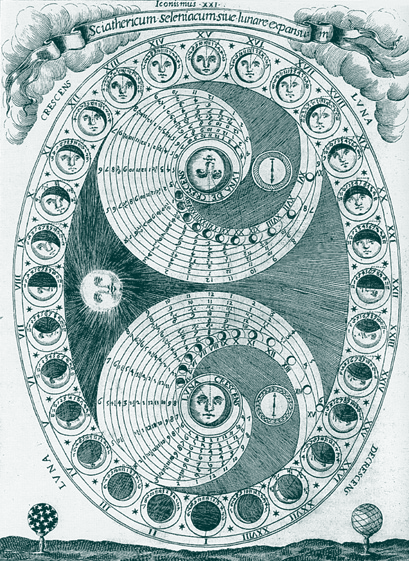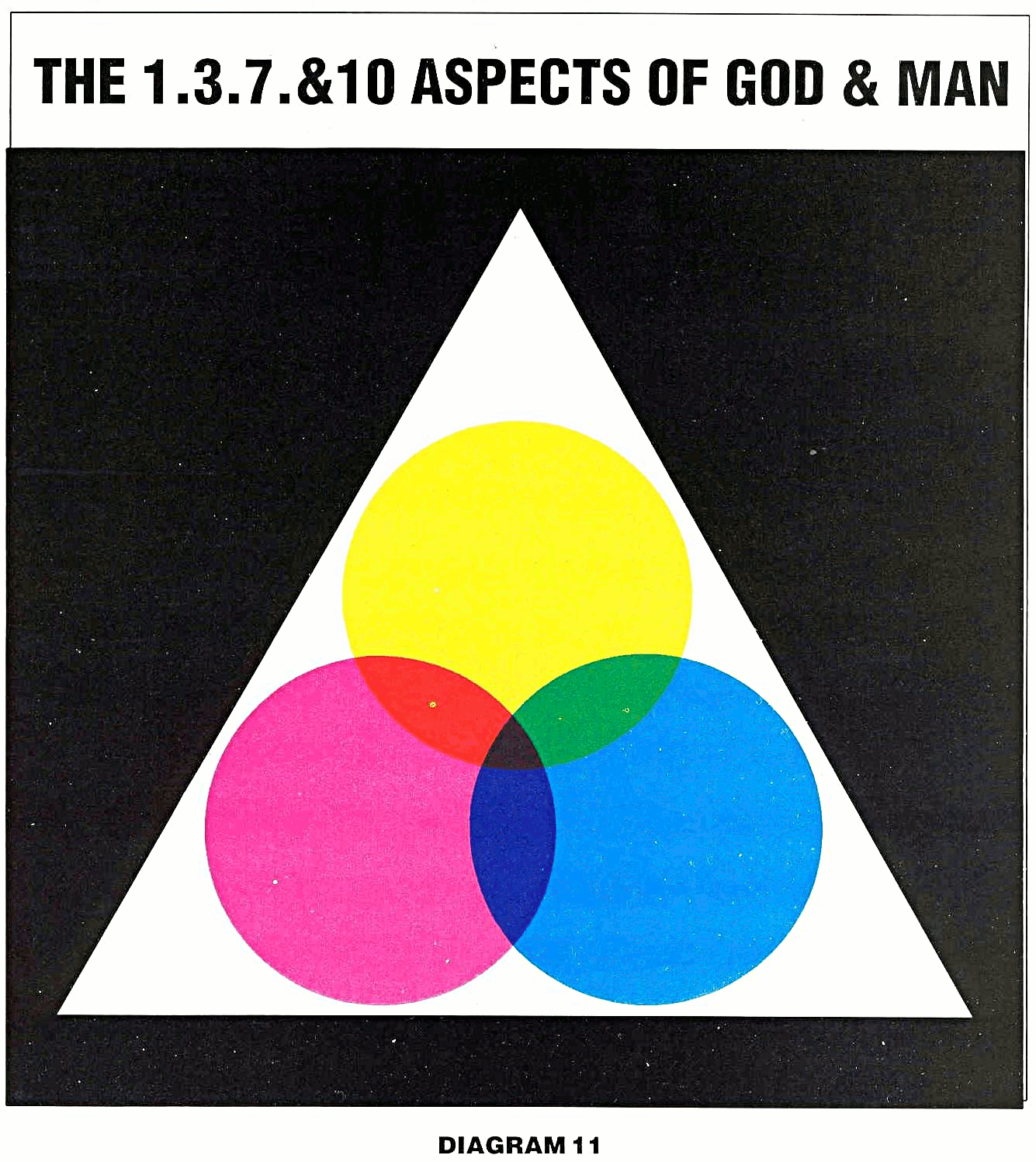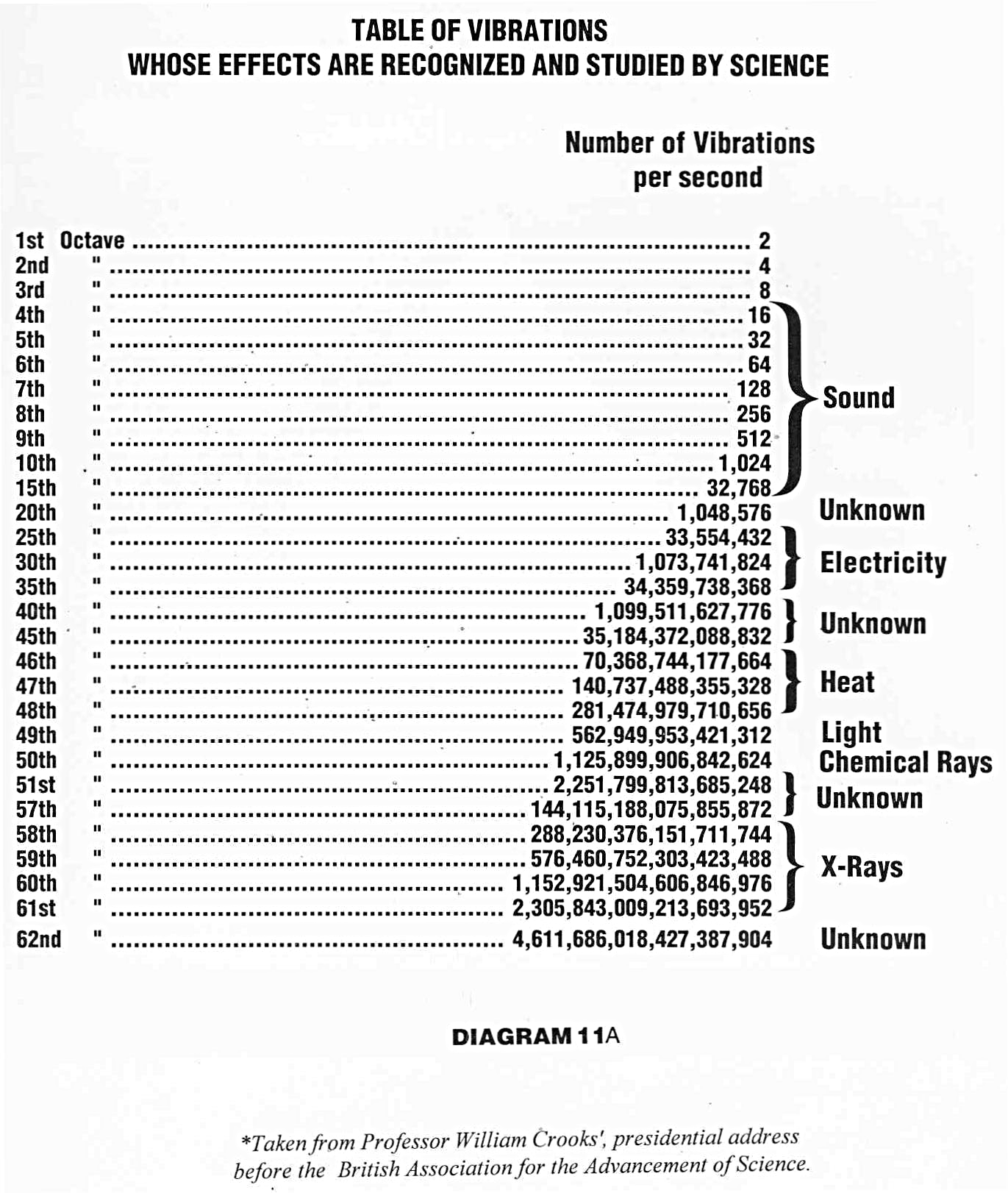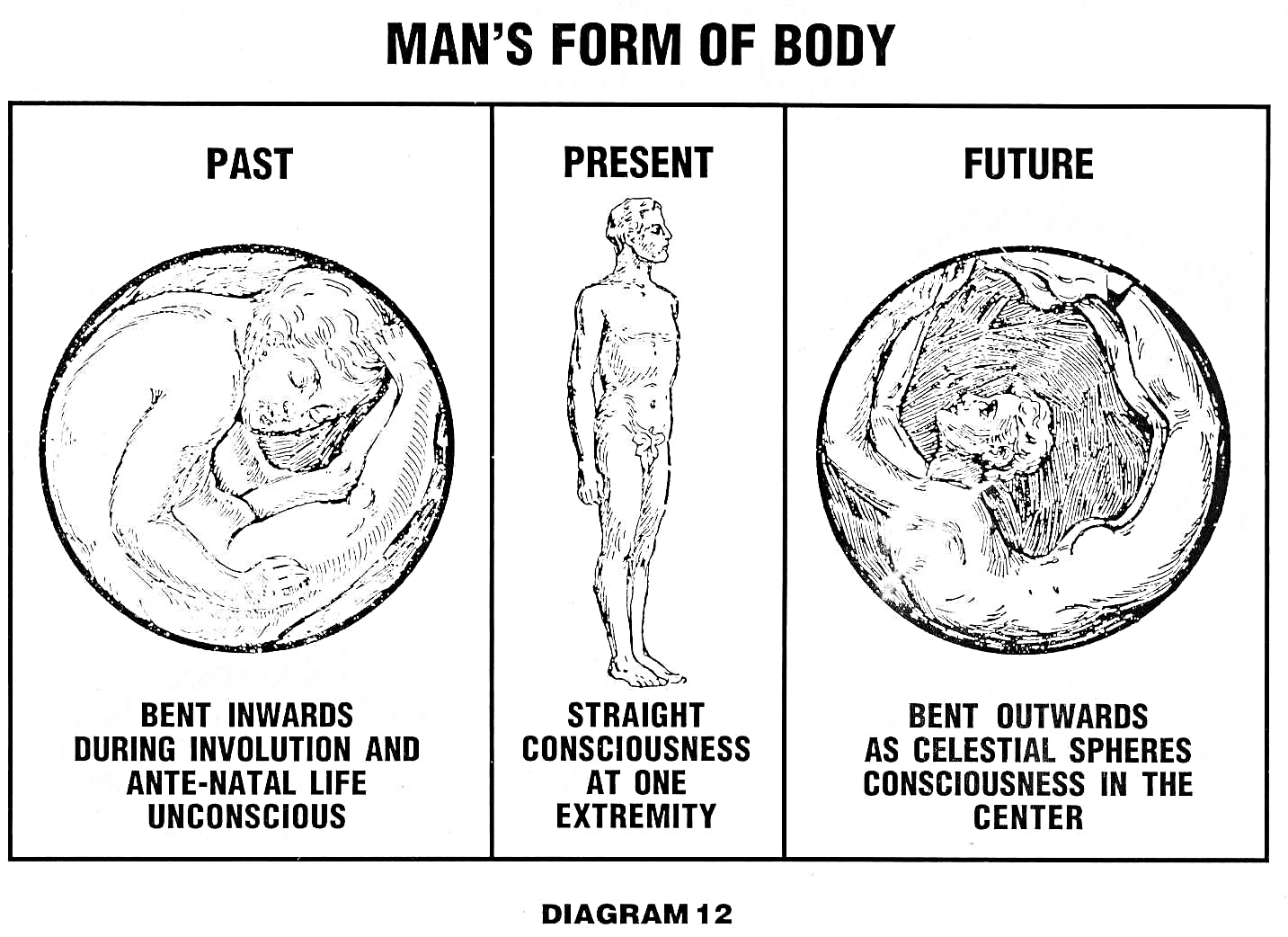

In the previous articles nothing has been said about our Solar System, and of different planets which compose it, because it was not until the Earth Period was reached that the present differentiation was made. The Earth Period is the acme of diversification, and although we have been speaking of only one class of Virgin Spirits — those who, in the strictest and most limited sense, are concerned with the Earth evolution — there are in reality seven "Rays" or streams of life, all pursuing different evolutions, yet all belonging to the original class of Virgin Spirits to which our humanity belongs.
In the previous Periods all of these different subclasses or Rays found a suitable environment for their evolution on the same planet. But, in the Earth Period, conditions became such that in order to provide for each class the degree of heat and the vibration necessary for its particular phase of evolution, they were segregated on different planets, at varying distances from the Sun — the central source of life. This is the raison d'etre of our System and all other Solar Systems in the Universe.
Before proceeding with the description of evolution of our humanity on the Earth after its separation from the central Sun, it is necessary for the maintenance of sequential order in the description to explain the differentiation which scattered the planets of our System in space.
Active manifestation — particularly in the Physical World — depends upon separateness; upon the limitation of life by form. But during the interim between Periods and Revolutions the marked distinction between form and life ceases. This applies not only to man and the lower kingdoms, but to the Worlds and Globes which are the basis of form for the evolving life. Only the seed-atoms and the nuclei or centers of the World-Globes remain — all else is one homogeneous substance. There is but one Spirit pervading space. Life and Form, its positive and negative poles, are one.
This state of things was what Greek mythology described as "Chaos." The ancient Norsemen and the Teutonic mythology call it "Ginnungagap," which was bounded upon the northern side by the cold and foggy "Niflheim" — the land of mist and fog — and upon the south side by the fire "Muspelheim." When heat and cold entered into space which was occupied by Chaos or Ginnungagap, they caused the crystallization of the visible universe.
The Bible also gives information on the idea of infinite space preceding the activity of the Spirit.
In our present materialistic period we have unfortunately lost the idea of all that lies behind that word Space. We are so accustomed to speaking of "empty" space, that we have entirely lost the grand and holy significance of the word, and are thus incapable of feeling the reverence that this idea of Space and Chaos should inspire in our breasts.
To the Rosicrucians, as to any esoteric school, there is no such thing as empty or void space. To them space is Spirit in its attenuated form; while matter is crystallized space or Spirit. Spirit in manifestation is dual, that which we see as Form is the negative manifestation of Spirit — crystallized and inert. The positive pole of Spirit manifests as Life, galvanizing the negative Form into action, but both Life and Form originated in Spirit, Space, Chaos!
To get an idea from everyday life which will illustrate, we may take the hatching of an egg. The egg is filled with a moderately viscous fluid. This fluid, or moisture, is subjected to heat, and out of the soft, fluidic substance comes a living chick, with hard bones and comparatively hard flesh, and with down that has a comparatively hard quill, etc.
When a living chick can come out of the inert fluid of an egg without the addition of any hardening substance from outside, is it a far-fetched idea to claim that the universe is crystallized Space or Spirit? There is not doubt that the claim will seem foolish to many; but this book is not for the purpose of convincing the world at large that these things are. It is intended to aid those who inherently feel that these things must be and to help them to see the light upon this great World-mystery, which the writer has been permitted to behold. The special object at present is to show that Spirit is active all the time — in one way during Manifestation, and in another during Chaos.
Modern science would sneer at the idea that life could exist upon a Globe which is in the process of formation. That is because science cannot dissociate Life and Form and cannot conceive of Form except as solid and tangible — cognizable by one of our five physical senses.
The Christian Mystic in accordance with the above definitions of Life and Form, holds that life may exist independently of Concrete Form; may have Forms not perceptible to our present limited senses, and amenable to none of the laws which apply to this present concrete state of matter.
It is true that the Nebular Theory holds that all existence (which is to say all Form, the Worlds in Space and whatever Forms there may be upon them) has come from the fiery nebular; but it does not recognize further fact insisted upon by Mystic Christianity — that the fiery nebula is Spirit. It does not admit that the whole atmosphere around us, the space between the worlds, is Spirit and that there is a constant interchange going on all the time — Form dissolving into Space, and Space crystallizing into Form.
Chaos is not a state which has existed in the past and has now entirely disappeared. It is all around us at the present moment. Were it not that old forms — having outlived their usefulness — are constantly being resolved back into that Chaos, which is also as constantly giving birth to new forms, there could be no progress; the work of evolution would cease and stagnation would prevent the possibility of advancement.
It is axiomatic that "The oftener we die, the better we live." The Poet-Initiate, Goethe says:
Who has not this —
Ever dying and bringing to birth —
Will aye remain a sorry guest
Upon this dismal earth.
and Paul says "I die daily."
Therefore, as students of Mystic Christianity, it is necessary to realize that even during active manifestation, it is Chaos that is the basis of all progress. Our life during Chaos is based upon our life in active manifestation, and vice versa, i.e., what we are able to achieve during active manifestation, and the ability to progress at all, is the result of the existence in Chaos. The interim between Periods and Revolutions is in reality much more important to the growth of the soul than concrete existence, though the latter is the basis of the former and therefore cannot be dispensed with. The importance of the Chaotic interim is in the fact that during that period the evolving entities of all classes are so closely united that they are really one; consequently those which are of lower development during manifestation are in closest contact with the more highly evolved, thus experiencing and benefiting by a much higher vibration than their own. This enables them to live over and assimilate their past experiences in a manner impossible when hampered by Form.
We have seen the benefit to the spirit in man from the interim between death and a new birth. There the form still exists, though much more attenuated that the dense body; but in the Cosmic Night and intervals of rest between Periods and Revolutions, when there is perfect freedom from form, the beneficial results of past experiences can be much more effectively assimilated.
We have a word which was originally coined to convey the idea of the state of things between manifestations. This word, however, has been used in a material sense to such an extend that it has lost its primal significance. That word is Gas.
It may be thought that this is a very old word, which has nearly always existed as a synonym for a state of matter lighter than liquids, but such is not the case. The word was first used in "Physica," a work which appeared in 1633, the author of it being Commenius, a Rosicrucian.
Commenius, did not call himself a Rosicrucian; no true Brother does so publicly. Only the Rosicrucian knows the brother Rosicrucian. Not even the most intimate friends or relatives know of a man's connection with the order. Those only who are Initiates themselves know the writers of the past who were Rosicrucians, because ever through their works shine the unmistakable words, phrases and signs indicative of the deep meaning that remains hidden from the non-Initiate. The Rosicrucian Teachings are now given publicly, because the world's intelligence is growing to the necessary point of comprehension. This work is one of the first few fragments of the Rosicrucian knowledge being publicly given out.
Rosicrucians such as Paracelsus, Commenius, Bacon, Helmont and others gave hints in their works and influenced others. The great controversy concerning the authorship of Shakespeare (which has to no avail blunted so many goose-quills and wasted so much good ink that might have served useful ends) would never have arisen had it been known that the similarity in Shakespeare and Bacon is due to the fact that both were influenced by the same Initiate, who also influenced Jacob Boehme and a pastor of Ingolstadt, Jacobus Baldus, who lived subsequent to the death of the Bard of Avon, and wrote Latin lyric verse. If the first poem of Jacob Baldus is read with a certain key, it will be found that by reading down and up the lines, the following sentence will appear: "Hitherto I have spoken from across the sea by means of the drama; now I will express myself in lyrics."
In his "Physica," Commenius, the Rosicrucian wrote: "Ad huc spiritum incognitum Gas voco," i.e., "This hitherto unknown Spirit I call Gas." Further on in the same work he says. "This vapor which I have called Gas is not far removed from the Chaos the ancients spoke of."
We must learn to think of Chaos as the Spirit of God, which pervades every part of infinity; it will then be seen in its true light, as the Mystic Christian maxim puts it: "Chaos is the seed-ground of the Cosmos," and we shall no longer wonder how "something can come out of nothing," because Space is not synonymous with "nothing." It holds within itself the germs of all that exists during a physical manifestation, yet not quite all; for by the wedding of Chaos with Cosmos there is something new brought forth each time, which did not exist before; something that was not foreshown and latent. The name of that something is Genius — the cause of Epigenesis.
It appears in all kingdoms. It is the expression of progressive spirit in man, animal and plant. Chaos is therefore a holy name; a name that signifies the Cause of all we see in Nature and inspires a feeling of devotion in every tried, true and trained Christian Mystic. He regards the visible sense world as a revelation of the hidden potentialities of the Chaos.
To express himself in the dense Physical World, it was necessary for man to evolve a suitable dense body. In a world like this he must have a body with limbs, organs, a muscular system by means of which to move about; also a brain to direct and coordinate his movements. If the conditions had been different the body would have been modified accordingly.
It is necessary for all beings, high or low in the scale of existence, to possess vehicles for expression in any particular world in which they may wish to manifest. Even the Seven Spirits before The Throne must possess these necessary vehicles, which of course are differently conditioned for each of Them. Collectively, They are God, and make up the Triune Godhead, and He manifests in a different way through each of Them.

There is no contradiction in ascribing different numbers to God. We do not sin against the "oneness" of light because we distinguish three primary colors into which it divides itself. The white light of the Sun contains the seven colors of the spectrum. The Christian Mystic sees even twelve colors, there being five between red and violet — going one way around the circle — in addition to the red, orange, yellow, green, etc., of the visible spectrum. Four of these colors are quite indescribable, but the fifth — the middle one of the five — is similar to the tint of a new blown peach blossom. It is in fact the color of the vital body. Trained clairvoyants who describe it as "bluish-gray," or "reddish-gray," etc., are trying to describe a color that has no equivalent in the physical world; and they are therefore compelled to use the nearest descriptive terms afforded by our language.
Perhaps Color will enable us to realize the oneness of God with the Seven Spirits before The Throne better than anything else. We will therefore turn to Diagram 11.
We see here a white triangle looming up from a dark background. White is synthetic, containing all colors within itself, as God contains within Himself all things in the Solar System.
Within the white triangle are a blue, a red and a yellow circle. All other colors are simply combinations of these three primary colors. These circles correspond to the three aspects of God, which are without beginning, and end in God; though externalized only during active manifestation.

When these three colors are interblended, as shown in Diagram 11, there appear four additional colors, the three secondary colors — each due to the blending of two primary colors — and one color (indigo) which contains the entire gamut of colors, making in all the seven colors of the spectrum. These colors represent the Seven Spirits before the Throne. The colors are different, as are also the Seven Spirits, each having a different mission in the Kingdom of God — our Solar System.
The seven planets circling around the Sun are the dense bodies of the Seven Planetary Genii. Their names are: Uranus with one satellite, Saturn with eight moons, Jupiter with four moons, Mars with two moons, the Earth and its moon, Venus and Mercury. (Astronomical discoveries have since attributed additional satellites to Uranus, Saturn, and Jupiter.)
Bodies are always found to suit the purpose they are made to serve, hence the dense bodies of the Seven Planetary Spirits are spherical, that form being best adapted to the enormous velocity with which they travel through space. The Earth, for instance, travels about 66,000 miles per hour in its orbit.
Man's body had a different shape in the past from that of the present, and from that which it will have in the future. During involution it was approximately spherical, as it still is during antenatal life, because the intrauterine development is recapitulation of past stages of evolution. At that stage the organism developed the sphere, because during involution man's energies were directed inward, upon the building of its own vehicles, as the embryo develops within the sphere of the uterus.
Man's dense and vital bodies have straightened, but his higher vehicles still retain their ovoid form. In the dense body, the coordinating and governing brain is situated at one extremity. This is the most unfavorable position for such an organ. Too long time is required for impulses to travel from one extremity to the other — from the brain to the feet, or for impacts on the feet to reach the brain. In cases of burns, for instance, science has demonstrated that valuable time is lost, the skin being blistered before a message can be carried from the injured place to the brain and back again.
This inefficiency would be greatly lessened if the brain were in the center of the body. Sensations and the responses thereto could be more quickly received and transmitted. In the spherical planets the Planetary Spirit directs from the center the movements of its vehicle. In future man will bend over, as shown in Diagram 12. He will become a sphere, directing his energies outward because a spherical form affords the greatest facility for motion in all directions, and indeed, for combination of simultaneous motions.
Mystic Christianity teaches that there is a further evolution in store for planets.
When the beings upon a planet have evolved to a sufficient degree, the planet becomes a Sun — the fixed center of a Solar System. When the beings upon it have evolved to a still greater degree, and consequently it has reached its maximum brilliancy, it breaks up into a Zodiac, becoming, so to speak, the womb for a new Solar System.
Thus the great hosts of Divine Beings who, until then, were confined within that Sun, gain freedom of action upon a great number of stars, whence they can affect in different ways the system which grows up within their sphere of influence. The planets, of man-bearing worlds, within the Zodiac are constantly being worked upon by these forces, but in various ways, according to the stage they have reached in evolution.
 Diagram #12:
Diagram #12:
Our Sun could not become a Sun until it had sent out from itself all the beings who were not sufficiently evolved to endure the high rate of vibration and the great luminosity of the beings who were qualified for that evolution. All the beings upon the different planets would have been consumed had they remained in the Sun.
This visible Sun, however, though it is the place of evolution for Beings vastly above man, is not by any means the Father of the other planets, as material science supposes. On the contrary, it is itself an emanation from the Central Sun, which is the invisible source of all that IS in our Solar System. Our visible Sun is but the mirror in which are reflected the rays of energy from the Spiritual Sun. The real Sun is as invisible as the real Man.
Uranus was the first planet to be thrown off from the nebula when its differentiation began in Chaos, at the dawn of the Earth Period. There was no light but the dim light of the Zodiac. The life that left with Uranus is of a rather backward strain and is said to evolve very, very slowly.
Saturn was next differentiated. It is the field of action for the life which is at the stage of evolution corresponding to the Saturn Period. This planet was differentiated before the ignition of the nebula and (like all nebula when passing through their Saturn Period of evolution) was not a source of light, but a reflector.
Jupiter was differentiated shortly afterwards, when the nebula had become ignited. The heat of Jupiter is not so great as that of the Sun, Venus or Mercury, but on account of its immense bulk, it is capable of retaining its heat and thus remains a suitable field of evolution for very advanced beings. It corresponds to the stage which will be reached by the Earth itself in the Jupiter Period.
Mars is a mystery, and only a limited amount of information may be given out. We may say, however, that the life on Mars is of a very backward nature and that the so-called "canals" are not excavations in the surface of the planet. They are currents such as, during the Atlantean Epoch, spread over our planet, and the remains of which can still be observed in the Aurora Borealis and the Aurora Australis. The shifting of the Martian "canals" noted by astronomers, is thus accounted for. If they were really canals, they could not possibly shift, but currents emanating from the Poles of Mars may do so.
The Earth, including the Moon, was next set out from the Sun, and later Venus and Mercury. These and Mars will be referred to later, in connection with the evolution of man on the earth, and need not be further considered at this time.
When a planet has Moons it indicates that there are some beings in the life wave evolving on that planet who are too backward to share in the evolution of the main life wave, and they have therefore been set out from the planet to prevent them from hindering the progress of the pioneers. Such is the case with the beings inhabiting our Moon. In the case of Jupiter it is thought probable that the inhabitants of three of its moons will eventually be able to rejoin the life on the parent planet, but it is thought that at least one of the others is an eighth sphere, like our own Moon, where retrogression and disintegration of the already acquired vehicle will result from too close adherence to material existence upon the part of the evolving beings who have brought themselves to that deplorable end.
Neptune and its satellites do not properly belong to our Solar System. The other planets — or rather their Spirits — exercise an influence over the whole of humanity, but the influence of Neptune is largely restricted to one particular class, the astrologers.
When laggards inhabiting a Moon have retrieved their position and returned to the parent planet; or, when continued retrogression has caused complete disintegration of their vehicles, the abandoned Moon also commences to dissolve. The momentum of a spiritual impulse which propelled it in a fixed orbit for aeons, may endure for aeons after the Moon has been vacated, and from the physical point of view it may still seem to be a satellite of the planet it encircles. As the time goes on, however, and the power of attraction exercised by the parent planet diminishes, its orbit widens, until it reaches the limit of our solar system. It is then expelled into interstellar space; dissolved in Chaos. The expulsion of these cinder-like dead worlds is analogous to the manner in which hard and foreign bodies embedded in the human system make their way through the flesh to the skin. The Asteroids illustrate this point. They are fragments of Moons which once encircled Venus and Mercury. The beings once confined upon them are known in esotericism as "The Lords from Venus" and "The Lords from Mercury;" they retrieved their lost estate in a large measure by service to our humanity, as will be later described, and are now safe on their present planet, while the Moons they inhabited have partly disintegrated, and are already far outside the earth's orbit. There are other "seeming" moons in our system, but they are outside the pale of evolution.